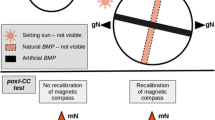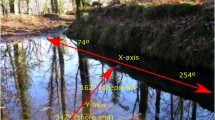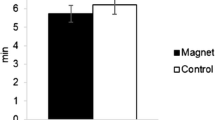Summary
-
1.
Radially symmetrical, four-armed tanks were designed for testing the directional preferences of sockeye salmon (Oncorhynchus nerka) fry as they commenced up-lake migrations following emergence from gravel nests and river migration to the lake.
-
2.
When tested during the day or night, as appropriate for their migration, fry from two different stocks moved in compass directions corresponding to the directions which they would have to maintain in their up-lake migration.
-
3.
The directional preferences of one population tested during the non-migratory time of day apparently corresponded to the fry's onshore movement.
-
4.
Orientation was maintained under both overcast and clear skies, and under plastic covers as well. A 90° counter-clockwise shift in the horizontal component of the earth's magnetic field was associated with approximately 90° changes in the mean direction of movement of fry at night, even when they were given a view of the sky. During the day, only fish tested in covered tanks displayed redirected movements in the altered field; those tested with a view of the sky showed geographically appropriate movement patterns despite the shifted field.
Similar content being viewed by others
References
Batschelet, E.: Statistical methods for the analysis of problems in animal orientation and certain biological rhythms. Washington, D.C.: Am. Inst. Biol. Sci. 1965
Bodznick, D.: Water source preference and lakeward migration of sockeye salmon fry (Oncorhynchus nerka). J. Comp. Physiol.127, 139–146 (1978)
Brannon, E.L.: Mechanisms controlling migration of sockeye salmon fry. Int. Pac. Salmon Fish. Commission Bull.21, 86 (1972)
Davitz, M.A., McKaye, K.R.: Discrimination between horizontally and vertically polarized light by the cichlid fishPseudotropheus macrophthalmus. Copeia1978, 333–334 (1978)
Dawson, J.J.: Determination of seasonal distribution of juvenile sockeye salmon in Lake Washington by means of acoustics. M. Sci. Thesis, University of Washington, Seattle (1972)
Dill, P.A.: Perception of polarized light by yearling sockeye salmon (Oncorhynchus nerka). J. Fish. Res. Bd. Can.28, 1319–1332 (1971)
Forward, R.B., Horch, K.W., Waterman, T.H.: Visual orientation at the water surface by the teleostZenarchopterus. Biol. Bull.143, 112–126 (1972)
Frankel, R.B., Blakemore, R.P., Wolfe, R.S.: Magnetite in fresh-water magnetotactic bacteria. Science203, 1355–1356 (1979)
Goodyear, C.P.: Terrestrial and aquatic orientation in the starhead topminnow,Fundulus notti. Science168, 603–605 (1970)
Goodyear, C.P., Ferguson, D.E.: Sun-compass orientation in the mosquitofish,Gambusia affinis. Anim. Behav.17, 636–640 (1969)
Groot, C.: On the orientation of young salmon (Oncorhynchus nerka) during their seaward migration out of lakes. Behav. Suppl.14, 198 (1965)
Hasler, A.D., Horrall, R.M., Wisby, W.J., Braemer, W.: Sunorientation and homing fishes. Limnol. Oceanogr.3, 353–361 (1958)
Hasler, A.D., Scholz, A.T., Horrall, R.M.: Olfactory imprinting and homing in salmon. Am. Sci.66, 347–355 (1978)
Kalmijn, A.: Experimental evidence of geomagnetic orientation in elasmobranch fishes. In: Animal migration, navigation, and homing. Schmidt-Koenig, K., Keeton, W.T. (eds.), pp. 347–353. Berlin, Heidelberg, New York: Springer 1978
Keeton, W.T.: Magnets interfere with pigeon homing. Proc. Natl. Acad. Sci. USA68, 102–106 (1971)
Kolb, R.: A review of Lake Washington sockeye (Oncorhynchus nerka) age and racial characteristics as determined by scale analysis. Unpublished report, State of Washington, Dept. of Fisheries (1971)
Kreithen, M.L.: Sensory mechanisms for animal orientation — can any new ones be discovered? In: Animal migration, navigation, and homing. Schmidt-Koenig, K., Keeton, W.T. (eds.), pp. 25–34. Berlin, Heidelberg, New York: Springer 1978
Loyacano, H.A., Chappell, J.A., Gauthreaux, S.A.: Sun-compass orientation in juvenile largemouth bass,Micropterus salmoides. Trans. Am. Fish. Soc.106, 77–79 (1977)
Neave, F.: Ocean migrations of Pacific salmon. J. Fish. Res. Bd. Can.21, 1227–1244 (1964)
Phillips, J.B.: Use of the earth's magnetic field by orienting cave salamanders (Eurycea lucifuga). J. Comp. Physiol.121, 273–288 (1977)
Royce, W.F., Smith, L.S., Hartt, A.C.: Models of oceanic migrations of Pacific salmon and comments on guidance mechanisms. Fish. Bull. U.S.66, 441–462 (1968)
Rubens, S.M.: Cube-surface coil for producing a uniform magnetic field. Rev. Sci. Instrum.16, 243–245 (1945)
Schmidt-Koenig, K.: Migration and homing in animals. Berlin, Heidelberg, New York: Springer 1975
Tesch, F.-W.: Influence of geomagnetism and salinity on the directional choice of eels. Helgol. Wiss. Meeresunters.26, 382–395 (1974)
Traynor, J.J.: Seasonal changes in the abundance, size, biomass, production and distribution of the pelagic fish species in Lake Washington. M. Sci. Thesis, University of Washington, Seattle (1973)
United States Dept. of Commerce: NOAA's Climatological Data, National Summary21(13) (1970)
Walcott, C., Gould, J.L., Kirschvink, J.L.: Pigeons have magnets. Science205, 1027–1029 (1979)
Wiltschko, W., Wiltschko, R.: Magnetic compass of European robins. Science176, 62–64 (1972)
Wiltschko, R., Wiltschko, W.: Relative importance of stars and the magnetic field for the accuracy of orientation in nightmigrating birds. Oikos30, 195–206 (1978)
Winn, H.E., Salmon, M., Roberts, N.: Sun-compass orientation by parrot fishes. Z. Tierpsychol.21, 798–812 (1964)
Woodey, J.C.: Distribution, feeding, and growth of juvenile sock-eye salmon in Lake Washington. Ph.D. Dissertation, University of Washington, Seattle (1972)
Author information
Authors and Affiliations
Additional information
I thank Dr. Ernest Brannon, whose knowledge of sockeye salmon biology and encouragement were essential in carrying out the study. Dr. Ronald Merrill provided valuable advice and criticism, especially concerning the theory and design of magnetic field altering equipment. Asko Hamalainen of the University of Washington's Fisheries Research Institute, and Clarence Miller and Forrest Scott of the International Pacific Salmon Fisheries Commission assisted with the fry collection and field work. Funds were provided by the Washington Sea Grant Program under the National Oceanic and Atmospheric Administration, U.S. Department of Commerce to Dr. Brannon. Drs. Brannon, Merrill and Theodore Pietsch criticized the manuscript.
Rights and permissions
About this article
Cite this article
Quinn, T.P. Evidence for celestial and magnetic compass orientation in lake migrating sockeye salmon fry. J. Comp. Physiol. 137, 243–248 (1980). https://doi.org/10.1007/BF00657119
Accepted:
Issue Date:
DOI: https://doi.org/10.1007/BF00657119




